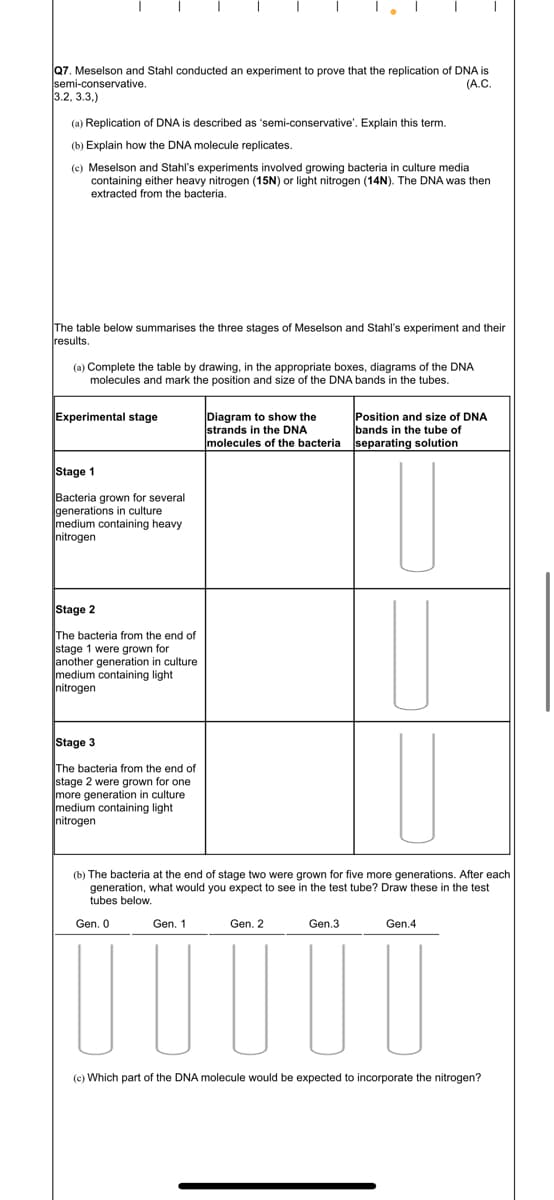Q7. Meselson and Stahl conducted an experiment to prove that the replication of DNA is semi-conservative. 3.2, 3.3,) (A.C. (a) Replication of DNA is described as 'semi-conservative'. Explain this term. (b) Explain how the DNA molecule replicates. (c) Meselson and Stahl's experiments involved growing bacteria in culture media containing either heavy nitrogen (15N) or light nitrogen (14N). The DNA was then extracted from the bacteria. The table below summarises the three stages of Meselson and Stahl's experiment and their results. (a) Complete the table by drawing, in the appropriate boxes, diagrams of the DNA molecules and mark the position and size of the DNA bands in the tubes. Experimental stage Diagram to show the strands in the DNA molecules of the bacteria separating solution Position and size of DNA bands in the tube of Stage 1 Bacteria grown for several generations in culture medium containing heavy nitrogen Stage 2 The bacteria from the end of stage 1 were grown for Janother generation in culture medium containing light nitrogen Stage 3 The bacteria from the end of stage 2 were grown for one more generation in culture medium containing light nitrogen (b) The bacteria at the end of stage two were grown for five more generations. After each generation, what would you expect to see in the test tube? Draw these in the test tubes below. Gen. 0 Gen. 1 Gen. 2 Gen.3 Gen.4
Q7. Meselson and Stahl conducted an experiment to prove that the replication of DNA is semi-conservative. 3.2, 3.3,) (A.C. (a) Replication of DNA is described as 'semi-conservative'. Explain this term. (b) Explain how the DNA molecule replicates. (c) Meselson and Stahl's experiments involved growing bacteria in culture media containing either heavy nitrogen (15N) or light nitrogen (14N). The DNA was then extracted from the bacteria. The table below summarises the three stages of Meselson and Stahl's experiment and their results. (a) Complete the table by drawing, in the appropriate boxes, diagrams of the DNA molecules and mark the position and size of the DNA bands in the tubes. Experimental stage Diagram to show the strands in the DNA molecules of the bacteria separating solution Position and size of DNA bands in the tube of Stage 1 Bacteria grown for several generations in culture medium containing heavy nitrogen Stage 2 The bacteria from the end of stage 1 were grown for Janother generation in culture medium containing light nitrogen Stage 3 The bacteria from the end of stage 2 were grown for one more generation in culture medium containing light nitrogen (b) The bacteria at the end of stage two were grown for five more generations. After each generation, what would you expect to see in the test tube? Draw these in the test tubes below. Gen. 0 Gen. 1 Gen. 2 Gen.3 Gen.4
Biology 2e
2nd Edition
ISBN:9781947172517
Author:Matthew Douglas, Jung Choi, Mary Ann Clark
Publisher:Matthew Douglas, Jung Choi, Mary Ann Clark
Chapter14: Dna Structure And Function
Section: Chapter Questions
Problem 17RQ: Which of the following is not a true statement comparing prokaryotic and eukaryotic DNA replication?...
Related questions
Question
Need help with Q7 downwards

Transcribed Image Text:Q7. Meselson and Stahl conducted an experiment to prove that the replication of DNA is
semi-conservative.
3.2, 3.3,)
(A.C.
(a) Replication of DNA is described as 'semi-conservative'. Explain this term.
(b) Explain how the DNA molecule replicates.
(c) Meselson and Stahl's experiments involved growing bacteria in culture media
containing either heavy nitrogen (15N) or light nitrogen (14N). The DNA was then
extracted from the bacteria.
The table below summarises the three stages of Meselson and Stahl's experiment and their
results.
(a) Complete the table by drawing, in the appropriate boxes, diagrams of the DNA
molecules and mark the position and size of the DNA bands in the tubes.
Experimental stage
Diagram to show the
strands in the DNA
molecules of the bacteria separating solution
Position and size of DNA
bands in the tube of
Stage 1
Bacteria grown for several
generations in culture
medium containing heavy
nitrogen
Stage 2
The bacteria from the end of
stage 1 were grown for
another generation in culture
medium containing light
nitrogen
Stage 3
The bacteria from the end of
stage 2 were grown for one
more generation in culture
medium containing light
nitrogen
(b) The bacteria at the end of stage two were grown for five more generations. After each
generation, what would you expect to see in the test tube? Draw these in the test
tubes below.
Gen. 0
Gen. 1
Gen. 2
Gen.3
Gen.4
(c) Which part of the DNA molecule would be expected to incorporate the nitrogen?
Expert Solution
This question has been solved!
Explore an expertly crafted, step-by-step solution for a thorough understanding of key concepts.
This is a popular solution!
Trending now
This is a popular solution!
Step by step
Solved in 3 steps with 2 images

Knowledge Booster
Learn more about
Need a deep-dive on the concept behind this application? Look no further. Learn more about this topic, biology and related others by exploring similar questions and additional content below.Recommended textbooks for you

Biology 2e
Biology
ISBN:
9781947172517
Author:
Matthew Douglas, Jung Choi, Mary Ann Clark
Publisher:
OpenStax

Human Heredity: Principles and Issues (MindTap Co…
Biology
ISBN:
9781305251052
Author:
Michael Cummings
Publisher:
Cengage Learning

Concepts of Biology
Biology
ISBN:
9781938168116
Author:
Samantha Fowler, Rebecca Roush, James Wise
Publisher:
OpenStax College

Biology 2e
Biology
ISBN:
9781947172517
Author:
Matthew Douglas, Jung Choi, Mary Ann Clark
Publisher:
OpenStax

Human Heredity: Principles and Issues (MindTap Co…
Biology
ISBN:
9781305251052
Author:
Michael Cummings
Publisher:
Cengage Learning

Concepts of Biology
Biology
ISBN:
9781938168116
Author:
Samantha Fowler, Rebecca Roush, James Wise
Publisher:
OpenStax College

Anatomy & Physiology
Biology
ISBN:
9781938168130
Author:
Kelly A. Young, James A. Wise, Peter DeSaix, Dean H. Kruse, Brandon Poe, Eddie Johnson, Jody E. Johnson, Oksana Korol, J. Gordon Betts, Mark Womble
Publisher:
OpenStax College